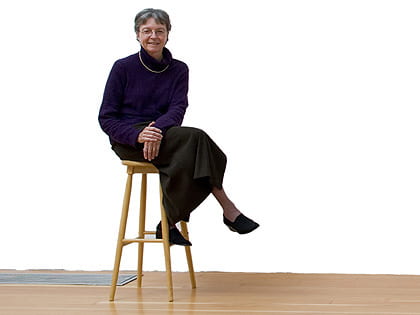Art of healing
Johanna Shapiro’s creative efforts infuse medical training with the human touch

Please let me remember
These thoughts
These pains
These fears
Every patient has
Even me
— excerpted from “Stream of Unconsciousness,”
Jennifer Jolley, M.D. ’04
Had Johanna Shapiro read these words in 1997 while recovering from surgery for a detached retina, she might have thought, “And even me, too.”
Indeed, the surgery had a powerful and unexpected impact on Shapiro, a UCI clinical psychologist and professor of family medicine. Her prognosis was favorable; moreover, she had access to the university’s wealth of science-based material to better understand her condition. Nonetheless, a sense of unease remained.
Shapiro recalls, “I suppose it was my first brush with my own vulnerability, even my own mortality. The clinical information I read left me feeling not more fulfilled — simply more informed.”
Shapiro’s discontent was exacerbated by a growing disenchantment for her own vocation, where she found the practice of psychology to be experiencing a decline in what she calls “the human touch” — an unspoken but essential connection between caregiver and patient. Believing she needed to reassess her professional life, Shapiro found herself at a career crossroad while still coming to terms with her personal health.
Then, while listening to an Emily Dickinson audio book, she found solace. The simple pathos of Dickinson’s words touched Shapiro in some fundamental way that the fact-based literature could not — and suddenly, says Shapiro, “I discovered a different, infinitely more rewarding path.”
Today, as director of the UCI School of Medicine’s Program in Medical Arts and Humanities, Shapiro stewards an interdisciplinary approach to education that embraces the oft-disregarded but real relationship between art and science. The program curriculum incorporates the study of literature and art, placing emphasis on creative expression through projects such as painting, reflective essays, videography, dance and music. Humanities proponents believe medical students become better equipped to acknowledge the fears of vulnerable patients and explore rather than suppress their own emotions — an essential treatment component, according to Shapiro, who notes, “Focusing on a group of symptoms is dehumanizing and ultimately detrimental to the doctor as well as the patient.”
Integrating the arts into medical education is not new, having been used in various forms for several decades. In many ways, it complements the concept of mind-body healing, encouraging its scholars to see medicine in a more human form. This transcends what some consider the conventional educational model, in which detachment and clinical observation supersede the patient-doctor connection. UCI’s humanities coursework balances the rigorous science-based traditional curriculum, providing a vehicle that assists student doctors in gaining greater awareness of their patients’ frailties and resulting in more edifying patient-physician relationships.
Shapiro researched parallels between medicine and the arts and discovered a plethora of sources — some fiction, some written by clinicians, patients and caregivers — ideal for incorporating into a medical school curriculum. And she found welcome encouragement from her UCI colleagues.
“Many told me, almost as a confessional, that they, too, had a great love for poetry or art, yet had lost touch with it,” recalls Shapiro.
Since the program’s 1997 launch, interest in the benefits of this unique approach to education and professional development has burgeoned, even though the bulk of coursework is not required for graduation. Except for an introductory lecture, a pediatrics clerkship and clinical-experience creative project, coursework is elective for credit or transcript notation. In 1999, the program debuted Plexus, a print and online journal featuring work by students, staff and faculty of the School of Medicine who find freedom and solace in creative expression.
Tonight I looked at the stars
Insight
For the first time I felt
Connected.
— excerpted from “Night Rain,” Cristin Gail Ryan, third-year medical student
“As physicians, it’s unreasonable to think we should coldly separate the physical aspects of treatment from the emotional and spiritual,” says third-year medical student Meghann Kaiser. “A major benefit of humanities study is that it requires me to consider things from a perspective other than the strictly technical.”
Fueled by a lifelong love of poetry, Kaiser believes her humanities studies deliver both professional and educational advantages, helping refine her communication skills while learning to maintain an emotional connection without being overwhelmed by a patient’s suffering.
“The humanities allow for greater self-focus,” says Kaiser, who served as Plexus editor in 2004, “including the fact that I’m human and my patient is human. This permits me to commit to finding a solution to my patient’s pain — or perhaps, admit that sometimes I can’t and be satisfied with that.”
“The humanities don’t resonate with all students,” acknowledges Dr. Lloyd Rucker, associate dean of curricular affairs and a core member of UCI’s medical humanities team, “but for those who do connect, it’s a compelling way for them to understand their experience.”
Rucker’s familiarity with using creative projects as training components predates 1997, having occasionally made them part of UCI’s internal medicine student rotation. A faculty co-adviser on Plexus, Rucker credits Shapiro for helping the UCI program thrive.
“Johanna is a powerful mix of clinician, observer, poet and advocate,” he says, “with a knack for seeing into the qualitative aspect of personal interaction. Johanna can watch a scene evolve between individuals and draw conclusions that make sense for entire systems.”
Suddenly, his individual and humble life explodes
And all his being is transformed into a magnificent body
Soaked up in the fascinating melody of life.
— excerpted from “Neural Transformation,”
Trung Minh Thai, M.D., Department of Psychiatry
Shapiro remains committed to communicating a crucial message: that medical students flourish in an environment that emphasizes that which is creative as well as scientific.
“There’s a stereotype of medical students as science nerds — not well-rounded individuals,” she explains, “when they are, in fact, very caring, creative, original souls. The humanities give students permission not only to think but also to ‘feel.’ And by nurturing rather than quashing this, we establish groundwork for what will someday make them truly outstanding physicians.”